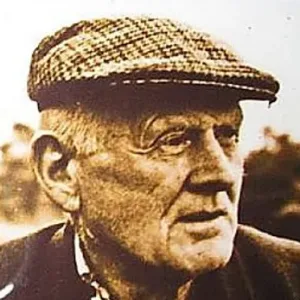
Seosamh Mac Grianna 1900 – 1990
He is undoubtedly one of the great writers of the revival; This is how Máirtín Ó Cadhain described him in November 1949 in the lecture ‘Do you understand that Irish language literature is not growing?’ (Feasta, March 1950): seo…. But there were certainly three of us — Pádraic Ó Conaire, an Piarsach, and Seosamh Mac Grianna — who would be considered true writers by any means. ‘ 1999 with Paul Murray; Seosamh Mac Grianna and other matters, 1970 with Proinsias Mac an Bheatha; Rí-éigeas na nGael: Memorial lectures on Seosamh Mac Grianna, 1994 edited by Nollaig Mac Congáil. Niall Ó Dónaill was a friend of his and his account in Scríbhneoireacht na gConallach, 1990 is edited by Nollaig Mac Congáil. Pádraig Ó Baoighill in Ó Ghleann go Fánaid: The Donegal Gaeltacht, 2000 describes his ancestors and the family of them. Ó Muirí has a bibliography and Seosamh Mac Grianna contributed by Mac Congáil
He himself states that he was born in August 1900 but the birth certificate received by Liam Doherty from the registrar in Stranorlar is 15 January 1901 (‘My Own Way: a work of modern literature’ in Scríobh 5, 1981); the birth was not registered until 9 February 1901 and it is interesting that much the same happened on the birthday of his brother Séamus Ó Grianna. Seosamh was born in Rann na Feirste near Anagaire. His father was Féilimí Dhónaill Phroinsiais, whom Séamus described (Rann na Feirste, 1942) as the best Irish language storyteller and speaker he had ever heard. His mother, Máire, was a sister of the famous storyteller Johnny Séamaisín Ó Domhnaill [Seán Ó Domhnaill B1]; what Séamus said about his predecessors was that they sang songs and poems as well as they did in Ireland during his time. The couple had ten other children and included: Domhnall Ó Grianna and Seán Bán Mac Grianna. Cousins of Neidí Frainc Mac Grianna, storyteller, and Domhnall Mac Grianna, Editor of An Gúim while Seosamh was translating books for them. ‘Mac Grianna’ is the correct form of the surname. He spent some time living with his brother James but they did not get along and whatever their relationship was later was turbulent.
He received his primary education in Rann na Feirste and was a monitor there. In 1916, he was awarded a scholarship to Adomnán College, Letterkenny, but remained there only a year. He spent a term of 1917 at St. Columba’s College, Derry, but was expelled; it would seem that the authorities considered it too disrespectful. In 1919 he won a King’s Scholarship and spent two years at St. Patrick’s College, Drumcondra, qualifying as a primary teacher. His first job was at Rann na Feirste School. It was a turbulent time. Pól Ó Muirí says: ‘Mac Grianna’s role during the War of Independence was one of propagandist and he took no active part in the fighting.’ He wrote a few plays in order to raise money for the local Defense Forces. He was opposed to the Anglo-Irish Treaty and Patrick Boyle says he was in a running column with his brother Donald during the Civil War. Together with his brother James he wrote a play in 1922 as propaganda against the Treaty, Freedom or tranquility ?? (From the Marine). It is said that after reading An Chéad Chloch by Pádraic Ó Conaire he decided to write in Irish. He was interned in Newbridge in the summer of 1922 with James, Donald and another brother of his, a Jew, and remained there until the end of the fighting. Ó Baoighill says that he and a Jew were among the internees who went on hunger strike in 1923. He spent the mid-1920s teaching here and there. ‘I was for a long time looking for work across the country from 1923 to 1925.. . . I had a teacher’s certificate during this time and taught for two weeks in Tyrone until I got an oath to give to the king of England. I taught another fortnight in one school in Dublin, six or seven weeks in Dundalk, a few more months in Dublin, two months west in county Mayo. Last year I spent a year on Mountbellew in County Galway ’(from the letter to Ó Droighneáin); his republicanism is thought to have made it difficult for him to find a permanent job but it is also thought that teaching caused his nervous breakdown in County Leitrim around that time. Apart from summer courses in Ó Méith and Rann na Feirste, he avoided the craft from then on. From 1924 onwards, he wrote essays and stories in: The Standard, The Irish Statesman, The United Irishman, Ulster, Fáinne an Lae, Iris an Fháinne, Humanitas, An Camán, An Phoblacht, Irish Press. . . . Mac Congáil has published some of the Irish language essays in Ailt, 1977 and further material, essays, reviews, letters, occasional poems, in both English and Irish, has been compiled by that scholar in Filí agus Felons, 1987, title Mac Grianna wrote a series of English language essays in An Phoblacht in 1926; This collection also contains an essay, ‘An Aisling’, which he wrote in 1953 and which was published on the 7 July 1972.
The original books he wrote at his peak were: Dochartach Dhuibhlionna agus Sgéaltaí eile, 1925 (new edition by Anraí Mac Giolla Chomhaill in 1976); Unreported Poets, 1926 (an account of the Dáil of Rann na Feirste in ancient times); Love and Gloom, 1929 (short stories); Eoghan Ruadh Ó Néill, 1931 (historical novel); Pádraic Ó Conaire and Other Essays, 1936 (new edition 1986); Wales, 1937; The Vikings, 1938; My Own Way and If the Bird Were Rubble, 1940 (both books under one cover); An Droma Mór, 1969. An Gúm published a new edition of Dá bhí ruball ar an Éan in 1993. Ó Muirí says that he wrote an English novel, The Miracle of Cashelmore, but it has not been published and the whereabouts of the manuscript are now unknown . He also says that another unpublished novel, Réamann Ó hAnluain, is in private ownership..
The books he translated for Gúm during 1925-32 are estimated at one and a half million words: Comin ’thro’ the Rye by Helen Mathers; The Black Sailor, 1933 (The Nigger of the Narcissus by Joseph Conrad); Ben Hur, 1933 (by Lew Wallace); The Whiteheaded Boy, 1934 (The Whiteheaded Boy by Lennox Robinson); Typhoon Bruithne, 1935 (Typhoon with Joseph Conrad); Islanders, 1936 (Islanders with Peter O’Donnell); Hangman’s House, 1935 (Hangman’s House by Donn Byrne); Almayer’s Folly, 1936 (Almayer’s Folly by Joseph Conrad); Ivanhoe, 1937 (Ivanhoe by Walter Scott); The Wreck of the Grosvenor, 1955 (The Wreck of the Grosvenor by W. Clark Russell); Adventures of a Younger Son, 1936 (E.J. Trelawny); Intertown, 1953 (Adrigoole by Peter O’Donnell). Conrad’s two titles, Séideán Bruithne and Amy Foster, 1935, are in one book (Modern Irish Literature Program 1, 1938). Niall Ó Dónaill says that Seosamh was chosen by Peadar O’Donnell to publish his book. transfer ‘when his health was failing and he was left with little exploitation’; Mac an Bheatha believed that by the end of 1936 he had begun to translate Adrigoole O’Donnell. A new edition of Muintir an Oileáin was published again in 1989 as an example of the best translations published by An Gúm. Gréagóir Ó Dúill says in Comhar, July 1990: ‘Books he translated as part of Irish literature — Eadarbhaile ar Adrigoole by Peadar O’Donnell and Séideán Bruithne on Typhoon by Joseph Conrad to name two examples.’
An accurate account of Mac Grianna ‘s views on Gúm and slavery associated with the translations can be found in Feasta, April 2002 (‘Donegal Irish Writers and the Gúm Translation Scheme’ by Nollaig Mac Congáil). The chapter ‘Mac Grianna, Ó Flaithearta, an Saorstát’ in Brown’s book relates to his hatred for him: . . ’. When Fianna Fáil came to power in 1932, the translation of books from English was abolished. Niall Ó Dónaill says: ‘The ban came, in large part, from the public complaints made by writers such as Seosamh himself about the Gúm translation system.’ what the payment system would suit him, is the occasional lump sum of money. The author says that: ‘The weight of translation (and the way in which Mac Grianna threw himself into it), allied to the demands of his own original work, was beginning to place an almost unbearable strain on his mental faculties.’ In addition, although An Gúm adopted the novel An Droma Mór in 1932, they were reluctant to publish it; they were afraid of being slandered. It is thought that the work would have been much more important if it had come out at that time; it was not published until 1969 and was awarded the Butler Prize. Seosamh Mac Grianna: Aistritheoir, 2005 is a study by Seán Mac Corraidh of a dozen of his translations for Gúm.
O’Donnell says that all those incidents described in My Own Way happened but that Mac Grianna skinned them; it is considered an autobiographical novel. The novel Had a Rubble on the Bird failed to finish and the final sentence is: ‘The well ran dry in the summer of 1935. I will not write any more. I did my best and I don’t care. ‘He lived with a woman named Peggy for a while. It is not certain that he was not married to her; she had previously been married to a sailor named O’Donnell and it is speculated that marriage, if any, was a blessing of the Catholic church. They had a son named Fionn but he was sent to the Christian Brothers orphanage in Glasnevin when the couple could not take proper care of him. Here is Ó Baoighill’s description of the woman: ‘Seosamh was married and I once spoke to his wife on the telephone in the Office of Comhdháil Náisiúnta na Gaeilge. . . . For as long as I can remember she called herself Peggy Green and was looking for money from Donncha Ó Laoire to help Seosamh. She was a clever woman who was fluent in the language and I was later told that she was always boasting about Seosaimh’s ability as a writer and that she was constantly tormented by Comhdháil Náisiúnta na Gaeilge and Raidió Éireann and some of the writer’s friends. looking for money. . . . They had one son, Fionn, who was tragically drowned in Howth Bay. ‘
He spent some time in Grangegorman in 1935-36. From then on life was bad for him. Mac an Bheatha gives an account of the visits he made to him from July 1954, and of the help he gave him, until he went to Rann na Feirste in 1957. He had one candlelight in this little house in Clones Bull. The rooms and furniture of the house were in poor condition; Peggy was not living with him at this time and could not give him any financial help. He often bought only bread but Mac an Bheatha’s most vivid description of his plight was perhaps this phrase: ‘I think he collected the cigarette butts from the road when he no longer had any cigarettes. and that he threw them in the pipe. ” Donncha Ó Laoire and Cearbhall Ó Dálaigh were among the others who tried to help him. In 1959, Peggy committed suicide and the same year the son drowned. Joseph was admitted to St. Conall’s Hospital in Letterkenny around that time and remained there. He suffered from schizophrenia, but this did not prevent him from later becoming involved in poetry and festivals in Donegal. It was in that hospital that he died on 11 June 1990.
Diarmuid Breathnach
Máire Ní Mhurchú
Full information above taken from the site ‘www.ainm.ie’ http://www.ainm.ie/Bio.aspx?ID=1580
Joseph’s Book’s:
An Dochartach Dhuibhlionna & Scéalta Eile. (1925) Read online ag: https://archive.org/stream/dochartachdhuibh00macguoft#page/n3/mode/2up
Filí Gan Iomradh (1926) Stationery Office, Dublin (an account of the old Dáil na Rann na Feirste)
An Grádh agus an Ghruaim (1929) Stationery Office, Dublin (short stories)
Eoghan Ruadh Ó Néill (1931) Stationery Office, Dublin (historical novel)
An Bhreatain Bheag (1937) Stationery Office, Dublin
Na Lochlannaigh (1938) Stationery Office, Dublin
Mo Bhealach Féin (1940) Stationery Office, Dublin
Dá mbíodh ruball ar an Éan (1940) Stationery Office, Dublin
An Droma Mór (1969) Stationery Office, Dublin
Filí agus Felons (1987) Eag. Connolly, December (Dublin, 1987).
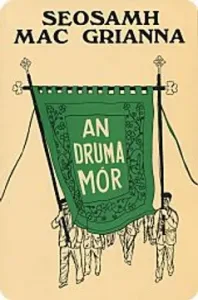
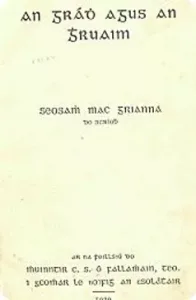
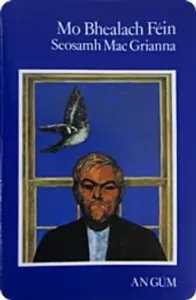
Aistriúcháin le Seosamh Mac Grianna
Teacht Fríd an tSeagal,(1932 ) Comin’ thro’ the Rye le Helen Mathers
An Mairnéalach Dubh,(1933) The Nigger of the Narcissus le Joseph Conrad
Ben Hur,(1933) Ben Hur le Lew Wallace
An Páistín Fionn,(1934) The Whiteheaded Boy le Lennox Robinson
Séideán Bruithne agus Amy Foster,(1935) Typhoon and Amy Foster le Joseph Conrad
Teach an Chrochadóra,(1935) Hangman’s House le Donn Byrne
Muintir an Oileáin,(1936) Islanders le Peadar O’Donnell
Díthchéille Almayer,(1936) Almayer’s Folly le Joseph Conrad
Imtheachtaí Fear Dheireadh Teaghlaigh,(1936) Adventures of a Younger Son le E.J. Trelawny
Ivanhoe,(1937) Ivanhoe le Walter Scott
Eadarbhaile,(1953) Adrigoole le Peadar O’Donnell
Báthadh an Ghrosvenor,(1955) The Wreck of the Grosvenor le W. Clark Russell


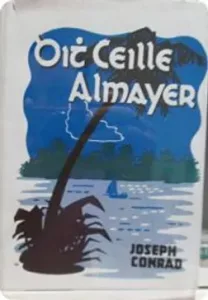
Ábhar Léirmheastóireachta ar shaothar Sheosaimh Mhic Grianna:
Riobard Ó Faracháin [Robert Farren], ‘Seosamh Mac Grianna’, The Bell, 1, 2 (Samhain. 1940), lgh.64-68
Breandán Ó Doibhlin, ‘Fear agus Finscéal: Dála An Druma Mór’, in Irisleabhar Mhá Nuad (1969), lgh.7-20;
Proinsias Mac an Bheatha, Seosamh Mac Grianna agus Cúrsaí Eile (BÁC: Foilseacháin Náisiúnta Tta. 1970)
Proinsias Mac Cana ‘An Druma Mór’, in Comhar (Bealtaine 1971), lgh.19-23;
Oilibhéar Ó Croiligh, Bealach Mhic Grianna (Corcaí/BÁC: Cló Mercier 1972), lch.47
Nollaig Mac Congáil, eag., Saothair Sheosaimh Mhic Grianna: Ailt Cuid a Dó (An Cabháin 1972)
Breandán Ó Doibhlin, ‘Fear agus Finscéal’ in Aistí Critice agus Cultúir (1974);
Liam Ó Dochartaigh, ‘Mac na Míchomhairle’, smaointe ar Mo Bhealach Féin, in Irisleabhar Mhá Nuad (Iúil 1975) lgh.13-16;
Seamus Deane, ‘Mo Bhealach Féin le Seosamh Mac Grianna’, in John Jordan, ed., The Pleasures of Gaelic Literature (BÁC/Corcaí: Mercier/RTE 1977)
Séamas Ó Saothraí, ‘Tar Éis Leathchéad Bliain’, léirmheas faoi Anraí Mac Giolla Chomhaill, eag., Dochartach Duibhlionna agus Scéalta Eile in Books Ireland (Meith 1977) lgh.118-19
Nollaig Mac Congáil, ‘Foinsí Béaloidis I nGearrscéalta Sheosaimh Mhic Ghrianna’, Comhar (Feabhra 1978)
Anraí Mac Giolla Chomhaill, eag., Saothair Sheosaimh Mhic Grianna, Cuid a hAon, Dochartach Duibhlionna agus Scéalta Eile (Coise Foilsitheoireachta Chomhaltas Uladh 1979) lch. 43
Seán Ó Mórdha, eag, Scríobh 5 [Mac Grianna Eagran Speisialta (Baile Átha Cliath: Clóchomhar 1981) (San áireamh: Declan Kiberd, ‘Mo Bhealach Féin, Idir Dhá Thraidisiún’, agus Liam Ó Dochtartaigh, ‘Mo Bhealach Féin: Saothar Nualtríochta’
Donnchadh Ó Baoill, ‘Druma Mór na Filíochta’, in Nua-Aois (BÁC NUI: Cumann Liteartha 1986) lgh 20-29
Cathal Ó Háinle, ‘An Druma Mór’, in Litríocht na Gaeltachta, Léachtaí Cholm Cille XIX (Maigh Nuad 1989) lgh.129-67;
Séamus Mac Annaidh Rubble na Mickies (1990) (Cuairt go Leitir Ceanainn ar Sheosaimh)
Nollaig Mac Congáil, eag., Seosamh Mac Grianna, ‘Iolann Fionn’: Clár Saothair (BAC Coiscéim 1990), 103pp. Aistí le Cathal Ó Háinle, Seosamh Watson, Liam Ó Dochartaigh, Diarmaid Ó Doibhlin, Pol Ó Muirí, Liam Lillis Ó Laoire, Eoghan mac Einrí.
Pól Ó Muirí, Flight from Shadow: The Life and Work of Seosamh Mac Grianna (Belfast: Lagan Press 1999), 213pp.;
Alan Titley, ‘Unfavourite Son’, review of Pól Ó Muirí, A Flight from Shadow: The Life and Works of Seosamh Mac Grianna, in Books Ireland (March 2000), pp.65-66
Fionntán de Brún, review of A Flight from Shadow: Life and Work of Seosamh Mac Grianna (Lagan 1999), in Fortnight [Belfast] (April 2000), pp.29-30;
Fionntán de Brún, Seosamh Mac Grianna: An Mhein Ruin (An Clochomhar 2002).
Pól Ó Murií, Seosamh Mac Grianna: Míreanna Saoil (Cló Chonnachta 2007) lch 180.
Catríona MacKernan, review of The Big Drum, in Books Ireland (Summer 2010), pp.133-3
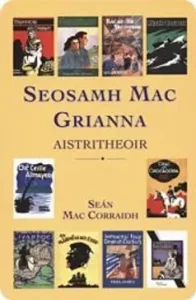


Aistriúchán ar leabhar Sheosaimh:


Hughes, Art J. (2010) (Aist) (An Druma Mór)
The Big Drum, Clólann Bheann Mhadagáin.
Léargas ghairid ar an saothar seo ag an nasc seo a leanas:
http://seosamhsonar.blogspot.ie/2010/04/druma-mor-big-drum.html
Suímh idirlín le heolas ar Sheosamh:
Ainm.ie Saol & Saothar Sheosaimh: http://www.ainm.ie/Bio.aspx?ID=1580
Déanann Éamonn Ó Dónaill leirmheas ar ‘Míreanna Saoil’ le Pól Ó Muirí: http://www.beo.ie/alt-leabharmheas-10.aspx
Páipéir Sheosaimh Mhic Grianna 1933-1957 (1972) 45 mír, Leabharlann Shéamais Uí Argadáin Ollscoil Éireann Gaillimh:
http://vmserver52.nuigalway.ie/col_level.php?col=G42
Treoir Idirlín ‘Searc’ chuig Éire sa 20ú haois:
